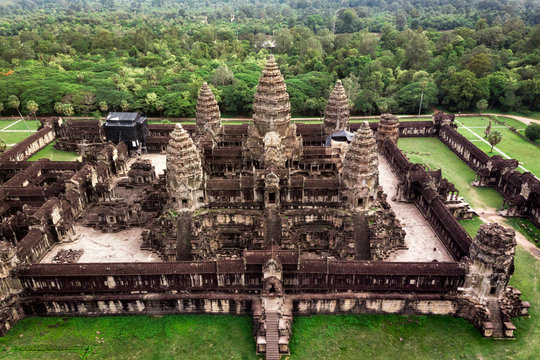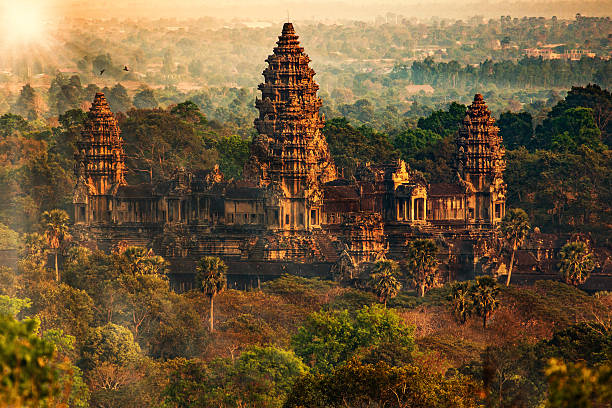Angkor Wat is a Hindu Buddhist Temple complex located in Siem Reap, Cambodia. Recognized as a UNESCO World Heritage Site, the most important archaeological site in Southeast Asia. Spread across 162 hectares of land, it combines 2 basic plans of Khmer temple architecture. It is considered one of the largest Hindu temples and religious monuments in the world.
Suggested Read; Tanjore Brihadeshwara Temple
Here are Some of the Interesting Facts About Angkor Wat Temple
1. Historical Significance

Angkor Wat was originally built during the 12th century by King Suryavarman II. Initially this temple was fully dedicated to the Hindu god Vishnu. A Hindu temple, later modified into a Buddhist temple during the end of the 12th century. According to some studies, the temple was dedicated to Buddhism as the king’s wife Indradevi devoted herself to Mahayana Buddhist.
2. Architectural Marvel

Spectacular vast temple, which is often known from its intrinsic and marvelous ancient architectural masterpiece. The temple complex covers an area of over 162 hectares of land, which is the total size of 200 football stadiums. Classical Khmer, temple mountain, and galleried temple designs feature a unique blend of architectural styles. It combines The Temple mountains and Galleried Temple. Today it is a major cultural, religious, and architectural site in the world representing the legacy of ancient art works.
3. Artistic Richness

We should not leave the artistic excellence in Angkor Wat temple. Walls, columns, lintels, roofs and even pillars are representing how artistically rich it is. The temple has intricate carvings and bas-reliefs that depict various Hindu mythological tales and historical events. Temples on each side of the opening are ornately decorated with intrinsic carvings. Impressive carving techniques exhibit important insights into the cultural and religious practices of the time.
4. Symbolism

As we said earlier, Angkor wat layout shows us the Hindu cosmology, with the central towers symbolizing Mount Meru. The mythical home of the gods in Hindu tales and Ramayana and Mahabharata stories. The moat surrounding the temple complex represents the ocean surrounding Mount Meru.
5. Tourism Icon

Angkor Wat is recognized by the UNESCO World Heritage site, which attracts millions of tourists from around the world. Despite being the largest religious monument in the world, Angkor Wat temple witnesses elements such as sunrise, cultural significance of Khmer civilization and artistic values making it a great destination in the world. Due to its architectural grandeur and historical significance make it one of the must-visit tourist destinations in the world.
6. Sunrise Spectacle

Never miss to enjoy exploring the beauty of Angkor Wat temple’s architecture during sunrise. The most crucial and iconic experience at Angkor Wat is witnessing the sunrise over the temple. Many visitors wake up early in the morning to observe and explore the breathtaking view as the first rays of sunlight illuminate the towers of the temple.
7. Restoration Efforts

Over the period of time, many steps and efforts have been made to preserve and restore Angkor Wat Temple beauty. The temple suffered damage during the Khmer Rouge regime and faced invasions for looting and natural calamities. Conservation and precautions projects have been undertaken to protect its important cultural heritage.
8. Surrounding Complex

Angkor Wat is just one part of the larger Angkor Archaeological Park; it is also home to a number of other ancient monuments and temples. Exploring the park allows visitors to dwell in the rich history and culture of the Khmer Empire.
Angkor Wat Enterprise will help you to book or purchase Tickets/ Entry Fees of Angkor Wat temple and other major surrounding Temples.
As a traveler, it is important to visit such a large temple irrespective of your religious background to enjoy artistic beauty as well as historical significance. Visiting Angkor Wat offers a glimpse into the ancient world and provides a profound understanding of Cambodia’s cultural heritage.
Related Articles: Temple of Heaven, Beijing, China.
Shitennoji Temple, Osaka, Japan.

